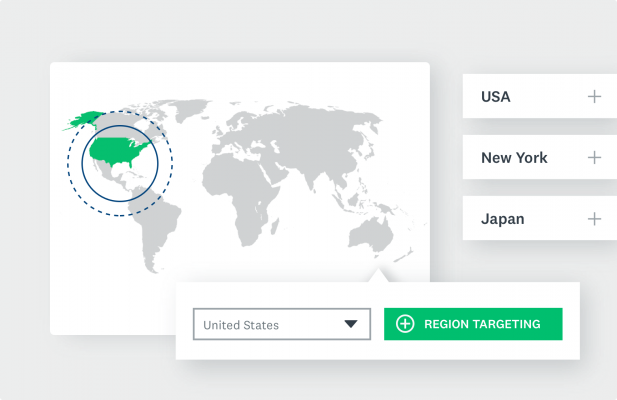More Resources
5 types of market segmentation and how to use them (with examples)

- Market segmentation is the practice of categorizing a broad consumer market into smaller, distinct groups based on shared characteristics.
- Market segmentation is crucial as it allows businesses to target specific groups more effectively, leading to better customer satisfaction and improved business performance.
- The five types of market segmentation include demographic, psychographic, behavioral, geographic, and firmographic segmentation.
Think of your customers like a vibrant mosaic, each one unique yet with threads of similarity weaving through them. Marketing segmentation is the art of recognizing these patterns, grouping customers based on their shared traits, and crafting strategies that resonate with their collective needs and desires.
After establishing groups with marketing segmentation, businesses can more effectively advertise to these segments. Each segment may have certain preferences that set them apart. As businesses focus on what each group wants to see, they can enhance engagement, boost interaction, and drive sales.
What is market segmentation?
Market segmentation is the process of dividing a broad population into subgroups according to certain shared factors. These groups may have common demographics (age, gender, etc.), geographic location, attitudes, behaviors, or a combination of similar characteristics.
Creating smaller groups based on common factors allows us to better target our audience.
Do you know your target market’s characteristics?
Find out in minutes with SurveyMonkey Consumer Segmentation.
Why use market segmentation
Market segmentation allows a business to develop detailed profiles of each market segment. Once these segments are clearly defined, marketers can create strategies for segments with the highest potential of buying their products and services.
To achieve that goal, marketers go through a three-step process that clarifies who people are and why they buy products.
- Segment: Marketers divide the market into categories based on shared traits.
- Target: They choose the market or target, who are most likely to buy their products.
- Position: Marketers research what product, price, promotion, and place combinations will attract customers to buy their products.
Once marketers isolate their target audience, they must define what’s different about their product. Is it better, faster, cheaper, or more advanced than competitive products? To answer these questions, marketers should understand their target audience's problems and how they can creatively solve those problems.
Companies create a competitive advantage for themselves through product differentiation, helping their products and services stand out as solutions for buyers’ issues.
By identifying a target market, isolating their problems, and creating a product that solves those problems, marketers have a higher probability of success over their competitors.
Market segmentation examples
Market segmentation is the first step for successful product marketing. Whether companies are marketing to consumers or businesses, market segments help companies better understand their customers’ problems and solve them.
Not every company segments its customers in the same way. There are several different approaches that businesses can use.
Here are three common examples of marketing segmentation.
No segmentation
Companies use mass marketing to sell their products to everyone, using an undifferentiated strategy. For example, commodities like salt or generic items with many substitutes may not spend much effort segmenting their market.
Limited segments
Firms may use one or more narrowly defined target markets to create a highly focused niche market for specialized products. Example: exclusive high fashion apparel, handmade art, or customized machinery parts.
Thousands of segments
Known as hyper-segmentation, marketers can customize a one-to-one marketing approach for each customer to develop a long-term relationship. For example, personalized services like hair salons and online retailers like Amazon offer personalized recommendations based on purchase history.
5 types of market segmentation
Whether you want to form a handful of segments or thousands, your business should understand the five different types of market segmentation.
Let’s break down demographic, psychographic, behavioral, geographic, and firmographic segmentation, what each involves, and how to use each type.
1. Demographic segmentation
Demographic segmentation assumes that people with common characteristics will have similar lifestyle patterns, tastes, and interests that will influence their purchasing habits. Demographics are often combined with other segmentation approaches to develop target markets with the greatest likelihood of buying their products.
Demographics include factors like age, gender, occupation, income, and education.
How to use demographic segmentation
The advantage of demographic segmentation is that it is easy to collect. Government sources, including the Bureau of Labor Standards, provide household, income, education, and health data for marketing strategy and business goals.
After using demographics for market segmentation, marketers can use this same information for customer segmentation. Using demographics and behaviors, they can identify:
- How big the market opportunity is for their product
- How their brand compares to the competition
- Which demographics are most likely to buy our product or service
- Which campaigns will resonate best with their target market
When combined with behavior traits and other variables, demographic segmentation provides valuable insights into understanding which specific customers within their target market will buy products and better understand how to reach them with the right marketing messages.
2. Psychographic segmentation
Psychographic segmentation divides people into groups based on their personality, lifestyle, social status, activities, interests, opinions, and attitudes. Psychographics are an excellent complement to demographics because they identify the motivations behind why people make particular choices.
Have you revisited your target market demographics lately?
Change happens fast. Get refocused with SurveyMonkey Consumer Segmentation.
How to use psychographic segmentation
Psychographic segmentation is a powerful way of understanding your customers’ problems, behaviors, and attitudes.
Companies use psychographics for market segmentation to understand:
- How consumers perceive their products and services
- What consumers really want and why
- Gaps or pain points with their current products or services
- Opportunities for future engagement
- How to better communicate with their target audience
3. Behavioral segmentation
Behavioral market segmentation describes specific steps in their ideal customer’s buying process. This form of segmentation includes what ideal customers want, why they want it, the benefits sought, and how they go about getting their needs met.
How to use behavioral segmentation
Businesses can use behavioral segmentation to study B2C and B2B market segments. When companies understand why people buy, they can better target their marketing messaging. Behaviors can include:
- Purchasing reason: Are buyers searching for the best price, excellent ratings, safety considerations, or other criteria?
- Occasion or event: Are consumers buying for a holiday or anniversary? Are B2B buyers trying to use up their budget before year-end?
- Product benefits: Is the buyer looking to purchase the latest technology, safest product, or be the first to buy the newest product?
- Buyer’s journey stage: Does the buyer want information for a future purchase? Or are they looking to try out the brand for the first time?
- Engagement level: Is the buyer a die-hard fan looking for the latest product?
When marketers know why consumers or businesses are buying their products, they can make it part of their segmentation strategy to address those behaviors.
4. Geographic segmentation
Geographic segmentation allows marketers to group people based on where they live, work, or travel.
Location has a significant influence on buying habits that marketers can use to develop their marketing messages. Marketers use various geographic segmentation variables that include the country, region, state, province, town, climate zone, or zip code.
Culture and population density (urban or rural) are also crucial variables to include in their market research. These location variables will influence what problems people have in that region and how marketers can solve them.

How to use geographic segmentation
Where a person lives can influence everything from their food choices to the car they drive. Businesses can use geographic segmentation to determine the best products to sell to their customers.
An example of geographic segmentation is marketing plants based on the climate zone. Geraniums will be best for hot and sunny locations and blue spruce for places with a harsh winter. Knowing the geographic area's details helps marketers identify which plants, soil, and gardening accessories will sell best in each climate.
Alternatively, a clothing company could recommend coats to someone living in a colder environment. Adapting the products you advertise to a customer based on their location can radically change how much they consider a purchase.
Related reading: The complete guide to segmentation surveys
5. Firmographic segmentation
Firmographic segmentation is to B2B marketers what demographics are for B2C marketers. Firmographics explain their business target market characteristics and include their industry, number of employees, legal status, company size, financial standing, and other business-related variables.
Millions of people move each year. Have your target market geographic profiles changed? Find out in hours with SurveyMonkey Consumer Segmentation.
How to use firmographic segmentation
Firmographics provide information for marketers who want to understand companies' strengths and viability within their target market. They focus on their financial performance and growth trends to see if the market segment is growing or experiencing a decline.
Firmographic data examples include:
- Industry classification: North American Industry Classification System (NAICS) code.
- Ownership and legal status: Ownership status, including sole proprietorships, limited liability corporations (LLCs), limited liability partnerships, private corporations, and public shareholder-owned corporations.
- Years in business: Years in business can be an indicator of financial strength and industry experience.
- Number of employees: The number of employees shows how large the company is. Location: Locations may include offices, manufacturing plants, or stores.
- Customers and products: What products does the company make or sell, and who their target audience is.
- Market size: How large is their market, and who are their competitors?
Benefits of market segmentation

Market segmentation is the basis for successful product concepts, launches, marketing messages, advertising, and other critical marketing activities.
Companies invest crucial resources into understanding their ideal customer’s problems to solve those challenges with valuable products and services. After investing time and effort into market segmentation, what is the benefit for companies?
Better advertising campaigns
Companies spend billions of dollars on marketing and advertising when they know exactly who their audience is and what they want. Marketers now collect vast amounts of data on their target audience to ensure their marketing messages appeal to the right customer, at the right time, for the right products.
Surveys are a great way to test marketing messages to see if they resonate with the target audience. They start by creating a hypothesis about how they think their survey respondents will react. The survey results help them build better messages and more successful campaigns.
Develop on-target products
Companies have great ideas for new products, but they must determine if those ideas solve a problem for their target audience. Without market segmentation, companies will waste time and effort on a product that sounds good but doesn’t sell.
Surveys help take the pulse of a target market. Within a few hours, companies can quickly find out if:
- They are solving a problem for their target market.
- One or more of their ideas is a clear winner.
- Their product concept has the right features, packaging, and logo.
- If buyers will purchase the product, and what price they will pay.
Getting the correct answers from a well-defined target market helps companies focus on successful products that their audience will buy.
SurveyMonkey’s Concept Testing solution will tell you if that new product idea is a winner. Receive a product performance scorecard with industry benchmarks.
Identify new trends and opportunities
Trends change quickly. Social media can provide insights into new customer behaviors, but marketers don't know if they are viable opportunities unless they measure those behaviors.
Understanding the behavior of a target market is the core of market segmentation. As new trends take hold, it is up to marketers to find out which ones are new opportunities and which ones will disappear overnight.
Marketers are responsible for identifying emerging customer problems, defining new marketing messages, and testing new product concepts. To identify new opportunities, marketers need to frequently test their target audiences for new insights and verify if customers still enjoy existing products.
Provide input to business operations
Market segmentation contains a robust data set that includes customer data that other departments can use to help the company succeed. In B2B companies, the marketing and sales departments are often closely linked, with sales depending on marketing to generate qualified leads that drive greater revenue.
The department in charge of pricing products also needs market and competitive data to correctly price products, helping them maintain a competitive edge. No manufacturing division suddenly wants to work overtime because of a sudden need for 100,000 widgets to meet increased demand, so sharing buyer trends and demand keeps production on track.
Market segmentation data is not meant just for the Marketing department. You should share it so the entire company can serve its customers.
Establish brand trust
Companies want to do more than just sell products to their target audience. They want to establish a relationship with their customers, so they keep buying products. When customers know, love, and continually buy a company’s products, they have created brand trust.
Market segmentation identifies which audience is most likely to buy not just once but also to make future purchases. By creating a brand identity that customers appreciate, firms start to raise brand awareness and build a trusted relationship with their target market. They stay focused on that trust, creating marketing messaging, new products, valuable content, and current information, creating a customer experience that keeps consumers and B2B clients returning for future purchases.
Target market segmentation helps marketers understand their ideal customers' problems and behaviors, creating solutions that build a long-term brand trust that benefits both parties.
What kind of relationship do you have with your audience?
Find out what it takes to build brand trust with SurveyMonkey Brand Tracker.
Segment your data with SurveyMonkey
Understanding market segmentation allows businesses to create more engaging, tailored content that every customer will love. Segmenting your audience is vital for delivering effective marketing materials and increasing engagement with your customers.
Learn more about how to segment your data with SurveyMonkey, creating detailed customer groups that enable highly effective business communications. Sign up today to get started with customer segmentation.
Get started with your market research
Global survey panel
Collect market research data by sending your survey to a representative sample
Research services
Get help with your market research project by working with our expert research team
Expert solutions
Test creative or product concepts using an automated approach to analysis and reporting
